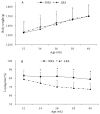Effects of Different Non-Cage Housing Systems on the Production Performance, Serum Parameters and Intestinal Morphology of Laying Hens
- PMID: 34199700
- PMCID: PMC8230062
- DOI: 10.3390/ani11061673
Effects of Different Non-Cage Housing Systems on the Production Performance, Serum Parameters and Intestinal Morphology of Laying Hens
Abstract
This study investigated the effects of plastic-net housing system (NRS) and floor-litter housing system (LRS) on the production performance, serum parameters and intestinal morphology of Shendan laying hens. A total of 1200 30-week-old hens were randomly allocated to the NRS and LRS groups, each of which included five replicates with 120 chickens in each replicate. The experiment was conducted from 32 to 40 weeks of age. Indoor airborne parameters were measured every 2 weeks, and indoor ground contamination was measured monthly. The laying rate and mortality of hens were recorded daily, and egg quality traits and serum parameters were measured every 2 weeks. At 40 weeks of age, four birds per replicate from each experimental group were selected for intestinal morphological observation. The results showed that the airborne bacteria number in the LRS was significantly higher than that in the NRS (p < 0.05) for most of the experimental period (except at 32 and 38 weeks of age), and the bacterial numbers on the surfaces of the floor and floor eggs in the LRS were approximately 10 times higher than those in the NRS (p < 0.05). Compared with the LRS, the NRS improved the laying rate (p < 0.05), reduced serum malondialdehyde (MDA) (p < 0.05) and corticosterone (CORT) concentrations and increased serum glutathione peroxidase (GSH-Px) and superoxide dismutase (SOD) activities, indicating favourable effects on antioxidative status. The NRS was significantly associated with an increased villus height (VH), villus height to crypt depth ratio (VCR) in the small intestine (p < 0.05) and increased VCR in the caecum (p < 0.05). Overall, the lower rate of bacterial contamination in the NRS than in the LRS indicated better environmental hygiene. The NRS enhanced the laying performance and antioxidant capacity of hens and was superior to the LRS in improving intestinal health. The current findings support the advantages of the NRS for the health and welfare of Shendan chickens during the peak laying period.
Keywords: intestinal morphology; laying hen; non-cage housing system; production performance; serum parameter.
Conflict of interest statement
The authors declare no conflict of interest.
Figures




References
-
- Ferrante V., Susanna L., Giuseppe V., Cavalchini L.G. Effects of two different rearing systems (organic and barn) on production performance, animal welfare traits and egg quality characteristics in laying hens. Ital. J. Anim. Sci. 2009;8:165–174. doi: 10.4081/ijas.2009.165. - DOI
-
- Tauson R. Management and housing systems for layers—Effects on welfare and production. World Poult. Sci. J. 2005;61:477–490. doi: 10.1079/WPS200569. - DOI
-
- Almeida E.A., Arantes de Souza L.F., Sant A.C., Bahiense R.N., Macari M., Furlan R.L. Poultry rearing on perforated plastic floors and the effect on air quality, growth performance, and carcass injuries—Experiment 1: Thermal comfort. Poult. Sci. 2017;96:3155–3162. doi: 10.3382/ps/pex131. - DOI - PubMed
Grants and funding
LinkOut - more resources
Full Text Sources

